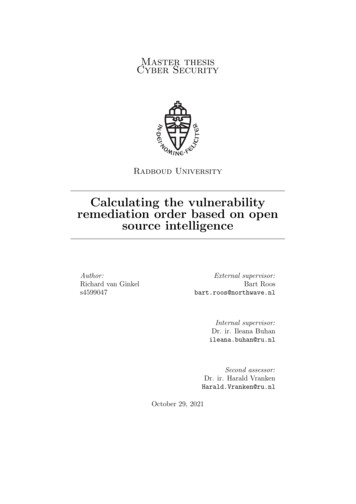
Transcription
Current Tool Support for Metrics in EAMCurrent Tool Support for Metrics inEnterprise Architecture ManagementMatheus Hauder1, Sascha Roth1, Christopher Schulz2, and Florian Matthes11Lehrstuhl für Software Engineering betrieblicher Informationssysteme (sebis),Technische Universität München (TUM), Garching b. München2SYRACOM AG, Garching b. Münchenmatheus.hauder@tum.de, roth@tum.de, tract:Today’s organizations are challenged with constantly changing marketrequirements and technological innovations. To address these challenges,Enterprise Architecture Management (EAM) emerged as an instrument to increaseflexibility and agility. Recently, metrics are gaining attention in practice to supportthe analysis of an Enterprise Architecture (EA) and their evolution. These metricsintent to measure organization-wide progress of transformations and facilitate theassessment thereof. Basis for these metrics are business processes, applications,infrastructure information, and their interrelations. The sheer amount of thisinformation, the efficient computation of EA metrics, and the communication ofrespective results requires adequate tool support. In this paper we present findingsfrom an empirical study on the current software for metrics in EAM. We describeprevailing solutions and give pointers to their future functionality spectrum.KeywordsEnterprise Architecture Management, Tools, Metrics, Survey1IntroductionEnterprise Architecture Management (EAM) is a commonly accepted means tocope with the growing complexity of organizations. In line with the ISO Standard42010 we define an Enterprise Architecture (EA) as the “fundamentalorganization of a system [enterprise] embodied in its components, theirrelationships to each other, and to the environment, and the principles guiding itsdesign and evolution” [7]. EAM considers an organization from a holistic point ofview [1] covering aspects like business capabilities, organization, applications,infrastructure, and data.EAM shares organizational visions and derives goals that work toward the sharedvision. Each individual EAM goal represents an objective contributing to at leastone business goal. However, unless the degree of fulfillment of these goals is notmade explicit providing hard evidence, proving the discipline’s actual benefit andMetriKon 2013
Matheus Hauder, Sascha Roth, Christopher Schulz, Florian Matthescontribution becomes hard. In consequence, concrete metrics as the calculationrule and Key Performance Indicators (KPIs) as “an item of information collectedat regular intervals to track the performance of a system [enterprise]” [3] are usedto quantify and measure the current/future state as well as the development of anEA [10].In the past, the prevailing perception in EAM has been a lack of metrics and KPIs[5, 8]. However, increasingly researchers like Matthes et al. [11] turn their focuson this topic while more and more EAM tools offer proper software support [2].In the light of this development, the support for metrics and KPIs by current EAMtools, i.e. their software-based definition, calculation, and display, is an interestingresearch area. Against this background, we conclude to the following researchquestions.1. Which EAM tools support the definition, calculation, and display of metricsand KPIs?2. How is this support realized by these tools?This article is structured as follows: in the next section, we present the researchmethodology we applied for answering the research questions. Subsequently, weelicit the different dimensions for an analysis of EA tools focusing on the supportof metrics. In Section 4 we present our dataset from a survey on EAM toolscomprising 13 solutions in total. In this sense, we give an overview on EAM toolsand their capabilities centering in particular on their metrics capabilities. Thepaper concludes with a brief outlook on further research topics.2MethodologyTo capture the current state on metric support through current EAM tools weconducted an exploratory online survey across multiple countries and industries.The first aim was to obtain a clearer picture to which extent current EAMsoftware solutions provide facilities to define, calculate, and present metrics.Additionally, the survey captured information about the respective tool vendor.Upon survey design, we performed a pre-test consisting of the completion of thecontained questions through three independent and non-related researchers (cf.[4]). The questionnaire was afterwards optimized according to the colleagues’feedback and suggestions. The final version of the questionnaire was accessible totool vendors for 21 days between July and August 2013.In parallel to the survey design we identified 43 EAM tool candidates usingcommon Internet search engines and publicly available tool survey material [2, 9,15, 16]. In July 2013 we contacted the identified vendors by mail and phoneinviting them to complete our questionnaire. In total, we sent over 1100 surveyinvitations via e-mail. The list of mail recipient experts has been compiled duringSoftware Metrik Kongress
Current Tool Support for Metrics in EAMpast EAM projects we performed with industry partners in the course of the last 8years. One week prior to closing, we sent out an electronic reminder. At the timewe closed the survey, 13 tool vendors had fully completed the questionnaire.Subsequent to an analysis of the resulting data, we documented the preliminaryresults.3Analysis dimensionsThis section explains the different analysis dimensions we took a closer look onwhen examining EAM tools in the light of metrics and KPIs. To obtaininformation on the organization behind a certain EAM tool solution the surveystarted with several questions regarding the vendor’s profile.In case the tool provides metrics facilities, the vendor was asked to specify if theEAM tool comes with predefined metrics. That is, whether the tool offers a set ofbuilt-in metrics that a user can directly choose from [9]. Built-in metrics ease thebarrier to use KPIs while relying on best-practice knowledge incorporated in themetrics’ formula. This way, a variety of ad hoc analyses can be performed in anefficient manner utilizing KPIs that are well-known and frequently applied inindustry. As an example, Figure 1 illustrates how the feature predefined metricscould look like in the EAM solution of Sparx Systems. As depicted, the metricUse Case Points (UCP) can be configured through the user who is allowed toadjust the predefined formula.Figure 1: Predefined metric configuration in Sparx’s Enterprise ArchitectMetriKon 2013
Matheus Hauder, Sascha Roth, Christopher Schulz, Florian MatthesWe further wanted to know if the EAM tool provides user interface support whenit comes to the definition of new metrics. As for predefined metric selection (cf.Figure 1), this support could be realized by means of a wizard or an editor. Anyguidance during the definition of metrics contributes to error-avoidance.Especially sophisticated heuristics can be employed to assist the user since atool-based realization of EA KPIs commonly relies on model-based calculations.An example is shown in Figure 2. For the previously specified metrics “ContractManagement Service Availability” a Layer8 user can, among others, define atarget value as well as a KPI category.Figure 2: Graphical wizard for the definition of metrics as provided byLayer8-Solutions’ Layer8Targeting at a higher expressive power, the vendors were questioned if their toolfeatures a domain specific language (DSL) for customized metrics definition [12].While predefined metrics and wizards guide the user and help to avoid errors,these mechanisms most certainly limit the solution space. Employing a DSL,users have a much higher degree of freedom. In practice that means users canbuild complex functions that build on a set of primitive mathematical functions orinvocations of other defined functions. For example, Figure 3 depicts a metricdefinition code snippet as realized in MEGA’s tool EA Solutions Powered byHOPEX. Such a DSL editor can be facilitated by code completion, syntaxhighlighting, and type checking.Software Metrik Kongress
Current Tool Support for Metrics in EAMFigure 3: DSL of the MEGA’s EA Solutions powered by HOPEXBesides the definition, an appropriate visualization of quantitative information (cf.[17]) is crucial for an effective management of EAs [6, 10, 14]. Consequently, weposed the question if the EAM tool also offers an integrated view or cockpit thatallows for a user-friendly presentation of (aggregated) KPIs. Figure 4demonstrates how such a cockpit (including explanations) looks like withinalfabet’s (Software AG) solution planningIT.Figure 4: Web-based dashboard as offered through planningITMetriKon 2013
Matheus Hauder, Sascha Roth, Christopher Schulz, Florian Matthes4Current tool support for EAM metricsTable 1 summarizes the different profiles of the vendors who participated andcompleted the survey. While the companies’ age ranges from 1 to 44 years, thecompany size varies between start-ups and major software industry player.Tool nameCompanyFoundingyearNumber BiZZdesignBiZZdesign200051-2504.2Corporate ModelerSuiteCasewise198951-2502011.4EA SolutionsMEGA ctSparx SystemsSoftware199911-5010iteraplaniteratec eanIXLeanIX nningITalfabet (Software AG)19695001-10.0008.1process4.bizprocess4.biz GmbH200311-506.0.0200111-505.4220111-101SAMU RepositoryTxtureAtoll TechnologiesLtd.QE-LaB BusinessServicesTable 1: Vendor profile and tool offeringAs our survey results in Table 2 reveal, 11 of 13 tools under examination offer adedicated metrics support. Of this set, 8 even provide a user interface for aSoftware Metrik Kongress
Current Tool Support for Metrics in EAMuser-friendly definition of metrics and associated KPIs. The same amount ofvendors ships their tool with a set of predefined metrics. When it comes to DSLs,as a more sophisticated feature, the current tool support is scarce. Only three ofthe 13 questioned vendors confirmed the respective capability. Finally, seventools feature an integrated view or cockpit to display several w orcockpitABACUSü ü ü ü ü BiZZdesignü ü û û û Corp. Modelerü ü ü û ü EA Solutionsü ü ü ü ü Enterprise Arch.ü ü ü û ü Iteraplanü ü ü ü ü Layer8ü ü ü û ü leanIXü û ü û û MappITû û û û û planningITü ü ü û ü Process4.bizü û û û û SAMU Repos.ü û û û û Txtureû û û û û ToolTable 2: Metrics support of surveyed EA toolsWhen asked for any additional features their tool provides with regards to metricsand KPIs in EAM vendors stated:§ Simulations using Monte-Carlo, activity-based, discrete-event, equationbased, and structural techniques (e.g., business process simulation)§ Import of metrics from third-party systems (e.g., project management tools)§ Export KPIs to third-party systems (e.g., Microsoft SharePoint, BusinessIntelligence applications)§ Visualization type to display KPIs (e.g., bar charts, line charts, pie charts)§ Continuous KPI monitoring mechanisms (e.g., time interval, trendreporting)MetriKon 2013
Matheus Hauder, Sascha Roth, Christopher Schulz, Florian Matthes5Summary and conclusionIn this paper, we presented findings from an empirical study on the current toolsupport for metrics in EAM. The article provided an overview on present EAMtools that support the definition, calculation, and display of metrics and KPIs(Section 4). Based on a subset of examined tools, we revealed insights on howmetric-related features are actually realized in today’s EAM tools (Section 3).Future work could examine the specific functionalities vendors indicated asadditional metric and KPI features. Since the data relies on the information givenby the vendor further validation is required. We seek to evaluate the statementsduring an extensive EAM tool survey we are going to tackle in Q4 of 2013 [13].This includes software installation, testing using EA scenarios and sample data.Results will be published in a comprehensive study due in Q1 2014.AcknowledgementsWe express our gratitude to all participating tool vendors for their support andopen information policy. Moreover, we would like to thank for the additional toolmaterial and brochures these organizations made available to us.References1. Aier, S., Riege, C., and Winter, R. (2008). Unternehmensarchitektur Literaturüberblick und Stand der Praxis. Wirtschaftsinformatik, 50(4), 292-304.2. Bittler, R. S. (2012). Magic Quadrant for Enterprise Architecture Tools (p. 28).Gartner Inc., Stamford, CT, USA.3. Fitz-Gibbon, C. (1990). Performance Indicators. Bera Dialogues. MultilingualMatters.4. Frazer, L., and Lawley, M. (2000). Questionnaire Design and Administration: APractical Guide. 1st ed. John Wiley & Sons Ltd, Milton, Australia.5. Grunow, S., Lenk, M. Roth, S. (2012). KPIs für die strategische Business/ITAlignment-Quantifizierung. Informatiktage, 219-222.6. Hauder, M., Roth, S., Pigat, S., and Matthes, F. (2013). A Configurator for VisualAnalysis of Enterprise Architectures. ACM/IEEE 16th International Conference onModel Driven Engineering Languages and Systems (MODELS 2013), Miami,USA.7. International Organization for Standardization. ISO/IEC 42010:2007 Systems andsoftware engineering - Recommended practice for architectural description ofsoftware-intensive systems, 2007.8. Kaisler, S, Armour, F. and Valivullah, M. (2005). Enterprise Architecting: CriticalProblems. Proceedings of the 38th Annual Hawaii International Conference onSystem Sciences (HICSS'05), IEEE Computer Society Washington, DC, USA.Software Metrik Kongress
Current Tool Support for Metrics in EAM9. Knoll, R., and Schulz, C. (2013). Enterprise Architecture Tool Survey 2013 (p. 78).Wiesbaden, Germany.10. Lankes, J. (2008). Metrics for Application Landscapes. Technische UniversitätMünchen. PhD Thesis.11. Matthes, F. Monahov, I. Schneider, A., and Schulz, C. (2012). EAM KPI Catalogv1.0. Technical Report, Technische Universität München, Germany.12. Monahov, I., Reschenhofer, T., and Matthes, F. (2013). Design and prototypicalimplementation of a language empowering business users to define KeyPerformance Indicators for Enterprise Architecture Management. 8th Trends inEnterprise Architecture Research Workshop, Vancouver, USA.13. Roth, S., Zec, M., Hauder, M., Schneider, A.W., and Matthes, F. (2014). EnterpriseArchitecture Management Tool Survey 2014, Technische Universität München,Technical Report (to appear).14. Schaub, M., Matthes, F., and Roth, S. (2012). Towards a Conceptual Framework forInteractive Enterprise Architecture Management Visualizations. In: Modellierung,Bamberg, Germany.15. Schekkerman, J. (2011). Enterprise Architecture Tool Selection Guide. Institute ForEnterprise Architecture Developments.16. Schweda, C. M., Matthes, F., Buckl, S., and Leitel, J. (2008). EnterpriseArchitecture Management Tool Survey 2008 (p. 278). Munich, Germany.17. Tufte, E. R., and Graves-Morris, P. R. (1983). The visual display of quantitativeinformation (Vol. 2). Cheshire, CT: Graphics press.MetriKon 2013
Matheus Hauder, Sascha Roth, Christopher Schulz, Florian MatthesSoftware Metrik Kongress
# Import of metrics from third-party systems (e.g., project management tools) # Export KPIs to third-party systems (e.g., Microsoft SharePoint, Business Intelligence applications) # Visualization type to display KPIs (e.g., bar charts, line charts, pie charts) # Continuous KPI monitoring mechanisms (e.g., time interval, trend reporting)











